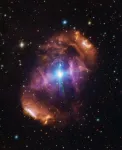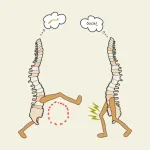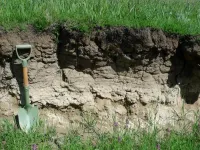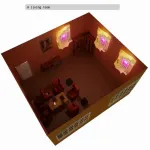(Press-News.org) When astronomers looked at a stellar pair at the heart of a stunning cloud of gas and dust, they were in for a surprise. Star pairs are typically very similar, like twins, but in HD 148937, one star appears younger and, unlike the other, is magnetic. New data from the European Southern Observatory (ESO) suggest there were originally three stars in the system, until two of them clashed and merged. This violent event created the surrounding cloud and forever altered the system’s fate.
“When doing background reading, I was struck by how special this system seemed,” says Abigail Frost, an astronomer at ESO in Chile and lead author of the study published today in Science. The system, HD 148937, is located about 3800 light-years away from Earth in the direction of the Norma constellation. It is made up of two stars much more massive than the Sun and surrounded by a beautiful nebula, a cloud of gas and dust. “A nebula surrounding two massive stars is a rarity, and it really made us feel like something cool had to have happened in this system. When looking at the data, the coolness only increased.”
“After a detailed analysis, we could determine that the more massive star appears much younger than its companion, which doesn't make any sense since they should have formed at the same time!” Frost says. The age difference — one star appears to be at least 1.5 million years younger than the other — suggests something must have rejuvenated the more massive star.
Another piece of the puzzle is the nebula surrounding the stars, known as NGC 6164/6165. It is 7500 years old, hundreds of times younger than both stars. The nebula also shows very high amounts of nitrogen, carbon and oxygen. This is surprising as these elements are normally expected deep inside a star, not outside; it is as if some violent event had set them free.
To unravel the mystery, the team assembled nine years' worth of data from the PIONIER and GRAVITY instruments, both on ESO’s Very Large Telescope Interferometer (VLTI), located in Chile’s Atacama Desert. They also used archival data from the FEROS instrument at ESO’s La Silla Observatory.
“We think this system had at least three stars originally; two of them had to be close together at one point in the orbit whilst another star was much more distant,” explains Hugues Sana, a professor at KU Leuven in Belgium and the principal investigator of the observations. “The two inner stars merged in a violent manner, creating a magnetic star and throwing out some material, which created the nebula. The more distant star formed a new orbit with the newly merged, now-magnetic star, creating the binary we see today at the centre of the nebula.”
“The merger scenario was already in my head back in 2017 when I studied nebula observations obtained with the European Space Agency’s Herschel Space Telescope,” adds co-author Laurent Mahy, currently a senior researcher at the Royal Observatory of Belgium. “Finding an age discrepancy between the stars suggests that this scenario is the most plausible one and it was only possible to show it with the new ESO data.”
This scenario also explains why one of the stars in the system is magnetic and the other is not — another peculiar feature of HD 148937 spotted in the VLTI data.
At the same time, it helps solve a long-standing mystery in astronomy: how massive stars get their magnetic fields. While magnetic fields are a common feature of low-mass stars like our Sun, more massive stars cannot sustain magnetic fields in the same way. Yet some massive stars are indeed magnetic.
Astronomers had suspected for some time that massive stars could acquire magnetic fields when two stars merge. But this is the first time researchers find such direct evidence of this happening. In the case of HD 148937, the merger must have happened recently. “Magnetism in massive stars isn't expected to last very long compared to the lifetime of the star, so it seems we have observed this rare event very soon after it happened,” Frost adds.
ESO’s Extremely Large Telescope (ELT), currently under construction in the Chilean Atacama Desert, will enable researchers to work out what happened in the system in more detail, and perhaps reveal even more surprises.
More Information
This research was presented in a paper entitled “A magnetic massive star has experienced a stellar merger” to appear in Science (www.science.org/doi/10.1126/science.adg7700). The paper will be published by Science in print on Friday, 12 April 2024, and will be released online at 14:00 U.S. Eastern Time Thursday (20:00 CEST), 11 April 2024. For the final version of the embargoed paper, please check https://www.eurekalert.org/press/scipak/ or contact scipak@aaas.org while the embargo lasts.
It has received funding from the European Research Council (ERC) under the European Union’s Horizon 2020 research and innovation programme (grant agreement number 772225: MULTIPLES; PI: Hugues Sana).
The team is composed of A. J. Frost (European Southern Observatory, Santiago, Chile [ESO Chile] and Institute of Astronomy, KU Leuven, Belgium [KU Leuven]), H. Sana (KU Leuven), L. Mahy (Royal Observatory of Belgium, Belgium and KU Leuven), G. Wade (Department of Physics & Space Science, Royal Military College of Canada, Canada [RMC Space Science]), J. Barron (Department of Physics, Engineering & Astronomy, Queen’s University, Canada and RMC Space Science), J.-B. Le Bouquin (Université Grenoble Alpes, Centre national de la Recherche Scientifique, Institute de Planétologie et d’Astrophyisique de Grenoble, France), A. Mérand (European Southern Observatory, Garching, Germany [ESO]), F. R. N. Schneider (Heidelberger Institut für Theoretische Studien, Germany and Astronomisches Rechen-Institut, Zentrum für Astronomie der Universität Heidelberg, Germany), T. Shenar (The School of Physics and Astronomy, Tel Aviv University, Israel and KU Leuven), R. H. Barbá (Departamento de Física y Astronomía, Universidad de La Serena, Chile), D. M. Bowman (School of Mathematics, Statistics and Physics, Newcastle University, UK and KU Leuven), M. Fabry (KU Leuven), A. Farhang (School of Astronomy, Institute for Research in Fundamental Sciences, Iran), P. Marchant (KU Leuven), N. I. Morrell (Las campanas Observatory, Carnegie Observatories, Chile) and J. V. Smoker (ESO Chile and UK Astronomy Technology centre, Royal Observatory, UK).
The European Southern Observatory (ESO) enables scientists worldwide to discover the secrets of the Universe for the benefit of all. We design, build and operate world-class observatories on the ground — which astronomers use to tackle exciting questions and spread the fascination of astronomy — and promote international collaboration for astronomy. Established as an intergovernmental organisation in 1962, today ESO is supported by 16 Member States (Austria, Belgium, Czechia, Denmark, France, Finland, Germany, Ireland, Italy, the Netherlands, Poland, Portugal, Spain, Sweden, Switzerland and the United Kingdom), along with the host state of Chile and with Australia as a Strategic Partner. ESO’s headquarters and its visitor centre and planetarium, the ESO Supernova, are located close to Munich in Germany, while the Chilean Atacama Desert, a marvellous place with unique conditions to observe the sky, hosts our telescopes. ESO operates three observing sites: La Silla, Paranal and Chajnantor. At Paranal, ESO operates the Very Large Telescope and its Very Large Telescope Interferometer, as well as survey telescopes such as VISTA. Also at Paranal ESO will host and operate the Cherenkov Telescope Array South, the world’s largest and most sensitive gamma-ray observatory. Together with international partners, ESO operates ALMA on Chajnantor, a facility that observes the skies in the millimetre and submillimetre range. At Cerro Armazones, near Paranal, we are building “the world’s biggest eye on the sky” — ESO’s Extremely Large Telescope. From our offices in Santiago, Chile we support our operations in the country and engage with Chilean partners and society.
Links
Research paper (preprint; for the final version of the embargoed paper, please check https://www.eurekalert.org/press/scipak/ or contact scipak@aaas.org while the embargo lasts)
Photos of the VLT/VLTI
Find out more about ESO's Extremely Large Telescope on our dedicated website and press kit
For journalists: subscribe to receive our releases under embargo in your language
For scientists: got a story? Pitch your research
Contacts
Abigail Frost
European Southern Observatory
Santiago, Chile
Tel: +44 79 8353 9292
Email: Abigail.Frost@eso.org
Hugues Sana
KU Leuven
Leuven, Belgium
Tel: +32 479 50 46 73
Email: hugues.sana@kuleuven.be
Laurent Mahy
Royal Observatory of Belgium
Brussels, Belgium
Tel: +32 476 23 60 06
Email: laurent.mahy@oma.be
Bárbara Ferreira
ESO Media Manager
Garching bei München, Germany
Tel: +49 89 3200 6670
Cell: +49 151 241 664 00
Email: press@eso.org
END
Beautiful nebula, violent history: Clash of stars solves stellar mystery
2024-04-11
ELSE PRESS RELEASES FROM THIS DATE:
A magnetic massive star was produced by a stellar merger
2024-04-11
Shedding light on why some massive stars have magnetic fields even though these stars’ interiors layers don’t undergo convection, researchers report observational evidence that magnetic fields form in some such stars through stellar mergers. The magnetic fields of low-mass stars, like the Sun, are produced by a dynamo generated in the convective layers of the star’s interior. Massive stars – those 8 or more solar masses at formation – do not have the convective interiors required to sustain magnetic fields in ...
Thin oil films enable stable oil and water mixtures sans surfactant
2024-04-11
Thin oil films absorbed onto the surface of water droplets lead to anomalously stable, surfactant-free oil and water mixtures, according to a new study. The findings demonstrate a mechanism for stabilizing water droplets in a water-oil emulsification without the need for a surfactant, which could have important technological applications, including the creation of very pure and controlled materials. Oil and water cannot form homogenous mixtures. Instead, when combined, droplets of one fluid will disperse inside the other, forming ...
*FREE* Growing tribal clean energy in the US
2024-04-11
New US federal legislation sets aside nearly $14 billion for 574 federally recognized indigenous nations and villages, which can be used to support tribal climate responsiveness and energy sovereignty. In a Policy Forum, Kimberly Yazzie and colleagues present a roadmap for designing, implementing, and funding projects and people to accelerate the renewable energy transition while also benefiting the indigenous entities involved. According to the authors, this opportunity positions indigenous communities to develop their economies and energy projects ...
The nitroplast revealed: a nitrogen-fixing organelle in a marine alga
2024-04-11
A nitrogen-fixing bacterial endosymbiont of marine algae is evolving into a nitrogen-fixing organelle, or nitroplast, according to a new study, thereby expanding a function that was thought to be exclusively carried out by prokaryotic cells to eukaryotes. Eukaryotic cells are remarkably complex and contain various organelles, which are specialized structures within a living cell that have specific biological functions. Two organelles, mitochondria and chloroplasts, play a key role in energy metabolism and ...
First step to untangle DNA: supercoiled DNA captures gyrase like a lasso ropes cattle
2024-04-11
Picture in your mind a traditional “landline” telephone with a coiled cord connecting the handset to the phone. The coiled telephone cord and the DNA double helix that stores the genetic material in every cell in the body have one thing in common; they both supercoil, or coil about themselves, and tangle in ways that can be difficult to undo. In the case of DNA, if this overwinding is not dealt with, essential processes such as copying DNA and cell division grind to a halt. Fortunately, cells have an ingenious solution to carefully regulate DNA supercoiling.
In this study published in the journal Science, researchers ...
Brainless memory makes the spinal cord smarter than previously thought
2024-04-11
Aya Takeoka at the RIKEN Center for Brain Science (CBS) in Japan and colleagues have discovered the neural circuitry in the spinal cord that allows brain-independent motor learning. Published in Science on April 11, the study found two critical groups of spinal cord neurons, one necessary for new adaptive learning, and another for recalling adaptations once they have been learned. The findings could help scientists develop ways to assist motor recovery after spinal cord injury.
Scientists have known for some time that motor output from the spinal cord can be adjusted through practice ...
Study reveals giant store of global soil carbon
2024-04-11
Soil carbon usually refers only to the organic matter component of soils, known as soil organic carbon (SOC). However, soil carbon also has an inorganic component, known as soil inorganic carbon (SIC). Solid SIC, often calcium carbonate, tends to accumulate more in arid regions with infertile soils, which has led many to believe it is not important.
In a study published in Science, researchers led by Prof. HUANG Yuanyuan from the Institute of Geographic Sciences and Natural Resources Research of the Chinese Academy of Sciences (CAS) and Prof. ZHANG Ganlin from the Institute of Soil Science of CAS, together ...
Wired to learn and remember
2024-04-11
Leuven (Belgium), 11 April 2024 — The role of the spinal cord is often simplified to that of a simple relay station, carrying messages between the brain and the body. However, the spinal cord can actually learn and remember movements on its own. A team of researchers at the Leuven-based Neuro-Electronics Research Flanders (NERF) details how two different neuronal populations enable the spinal cord to adapt and recall learned behavior in a way that is completely independent of the brain. These remarkable ...
Penn Engineers recreate Star Trek’s Holodeck using ChatGPT and video game assets
2024-04-11
In Star Trek: The Next Generation, Captain Picard and the crew of the U.S.S. Enterprise leverage the holodeck, an empty room capable of generating 3D environments, to prepare for missions and to entertain themselves, simulating everything from lush jungles to the London of Sherlock Holmes. Deeply immersive and fully interactive, holodeck-created environments are infinitely customizable, using nothing but language: the crew has only to ask the computer to generate an environment, and that space appears in the holodeck.
Today, virtual interactive environments are also used to train robots prior to real-world deployment in a ...
UC Santa Cruz researchers value salt marsh restoration as a crucial tool in flood risk reduction and climate resilience in the San Francisco Bay
2024-04-11
Salt marsh restoration can mitigate flood risk and bolster community resilience to climate change in our local waterways, according to a recent study published in Nature by a postdoctoral fellow with UC Santa Cruz’s Center for Coastal Climate Resilience (CCCR).
The study, titled “The value of marsh restoration for flood risk reduction in an urban estuary,” explores the social and economic advantages of marsh restoration amidst the growing threats of sea level rise and storm-driven flooding. Climate change will put many communities at risk. In California, some of the study co-authors from the U.S. Geological ...



